Contents
Clematis bush is no less picturesque garden plant than spectacular climbing varieties. Low-growing undemanding species are suitable for growing in a temperate climate zone. Bush clematis decorate the garden with flowering from mid-summer to autumn.
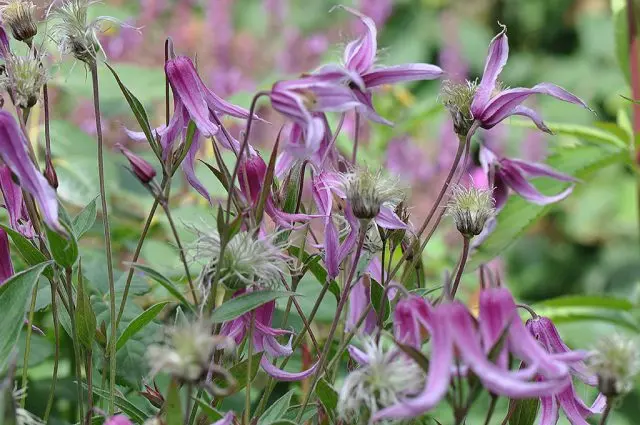
Description of bush clematis
The herbaceous perennial bush of these numerous species of clematis rises from 45 to 100 cm, feeds on filamentous roots, which extend in a bunch from the central trunk. Hybrid plants are larger, reach 2 m, but young flexible shoots look like thin grass stems, require support and garters. In some varieties of undersized bush clematis, the leaves are elongated, ovate, with a pointed tip, located oppositely on the stem. On other bush species, leaf blades of various shapes grow.
On the shoots, 7-10 single drooping flowers are formed in the form of a bell, consisting of individual petals. The diameter of the flower is from 2 to 5 cm, in hybrid forms – up to 25 cm. The color and number of petals varies from species and varieties of spray clematis: from 4 to 6 – white, purple, pink, blue. Clematis corollas bloom from the end of June, flowering lasts up to a month, but some varieties continue to bloom until September. In autumn, most bush species have very decorative fluffy seedlings. Plants winter well in the middle lane and in the Urals.
Among the bush clematis, the most famous species are:
- straight with white small flowers;
- whole-leaved;
- hogweed;
- shrub lobed and others.
Bush clematis is also called clematis, which reflects the definition of the plant genus. Another name, princes, is rather erroneous, since in botany it denotes a completely different type of liana from the clematis genus.
Varieties of bush clematis
The most common bush species is whole-leaved clematis. In the temperate zone, several dozen varieties are grown. Often nursery employees sell them, adding to the name of a particular bush variety and the Latin species definition: Integrifolia (integrifolia) – whole-leaved. Other species are also found in amateur gardens.
Alenushka
One of the most impressive touching beauty of bush clematis, judging by the photo and description. Shoots grow up to 2 m, they are tied up or sent to some shrub, they are also formed as a ground cover. In complex pinnate leaves up to 5-7 lobules. The size of clematis flowers, consisting of 4-6 mauve, outward-curved sepals, is up to 5-6 cm. It grows in the sun and in the shade.
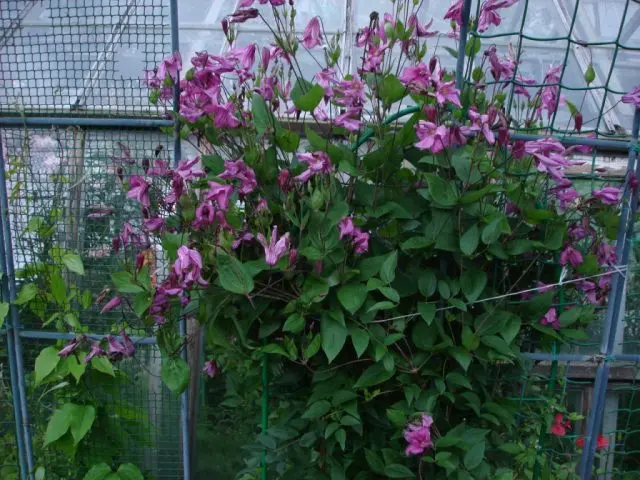
Jean Fopma
The shrub plant of the whole-leaved species Jan Fopma reaches 1,8-2 m, the shoots do not cling, they are tied to a support. Flowers up to 5-6 cm, consist of pinkish sepals with a bright light pink, almost white border, and a lush white center. Bush clematis blooms from late May to late August.
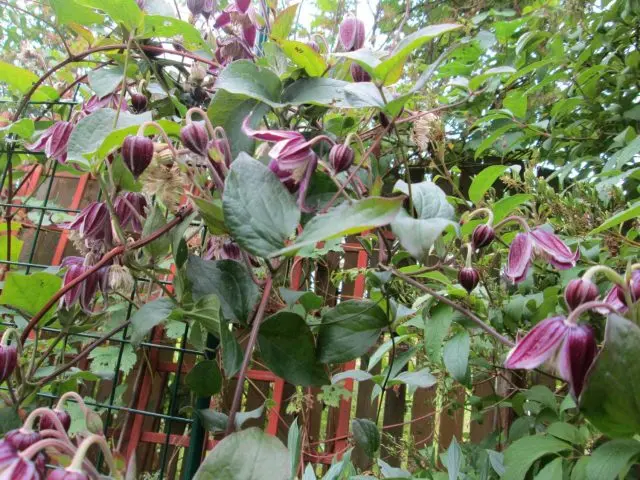
Hakura
Whole-leaved clematis bush Hakuree grows up to 80-100 cm. The plant is supported by shoots on a low trellis. The bell-shaped flowers are white on the outside and bloom from late June to autumn. Wavy sepals-petals on the inside are light purple, twist in an original way.
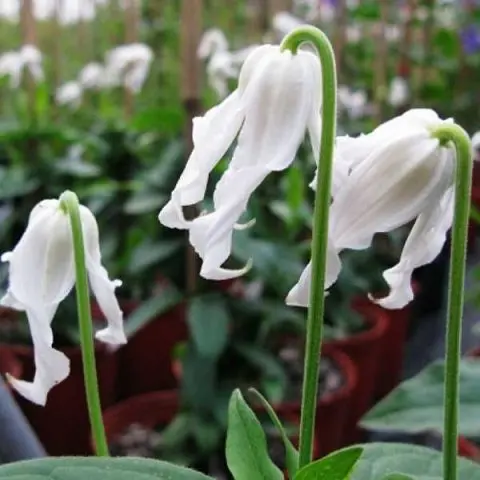
Alba
White bush clematis Alba species Integrifolia is undersized, only 50-80 cm in height. Flowers 4-5 cm, bloom from the twentieth of June to the end of August. Heavy rains reduce the decorative effect of the delicate corolla of spray clematis.
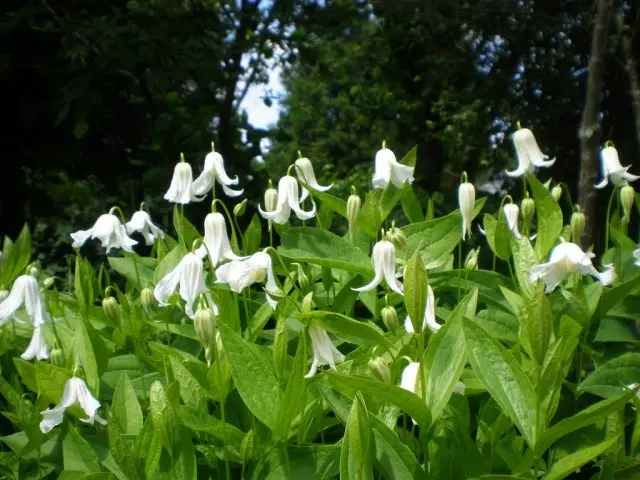
Blue Rain
Small-flowered bush clematis Blue Rain Integrifolia can drive out shoots up to 2 m, which must be tied up. Blooms profusely from mid-summer to early autumn. A bell-shaped corolla of four bright purple-blue petals reaches a length of 4 cm.
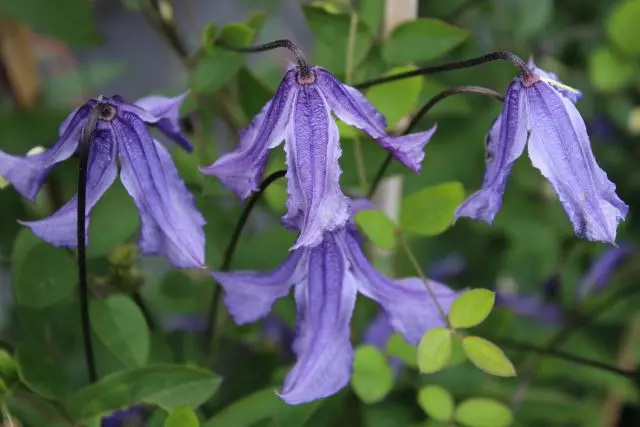
Direct white-flowered
Clematis bush white small-flowered has a species definition – straight (Recta). The root system of this very picturesque species is pivotal, it develops better in slightly acidic soil. The stems are thin, up to 1,5, sometimes 3 m, they are tied up or allowed along a low fence. The flowers are small, up to 2-3 cm – graceful, with a white corolla of 4-5 petals, reminiscent of a myriad of stars on a bush.

Straight Purpurea white-flowered
This bush clematis, as in the photo of the Recta Purpurea variety, has the same small white flowers as the original plant, but the leaves are purple in color. A spectacular bush is planted near the fences, directing and tying the shoots.
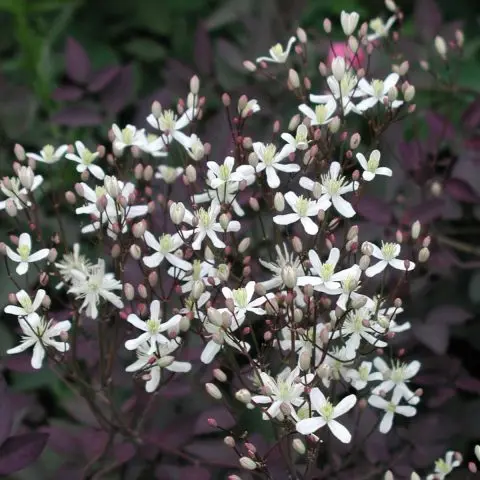
love radar
Tall bush variety of clematis of the Tangut species with feathery graceful leaves. Sometimes the name sounds like Love Locator. The original undersized plant, originally from China and Central Asia, was loved by gardeners with bright yellow bell flowers. Hybrids reach up to 2,5-3,7 m, they are also painted in cream or orange.
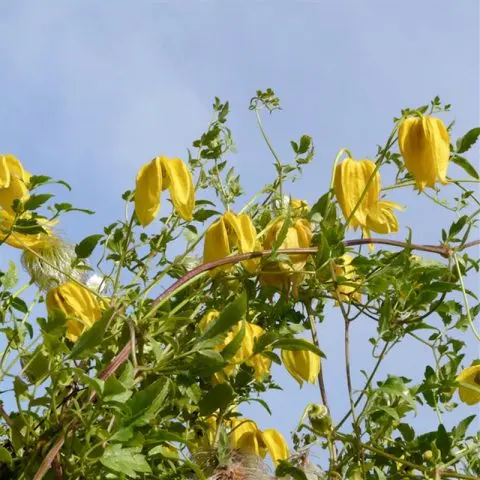
Clematis brown Isabelle
There is a bush view from the Far East, it grows up to 1,4-1,9 m. Curved sepals-petals of an unusual brown hue, but an exquisite goblet shape, create a flower up to 2,5 cm in diameter. Blooms in the fourth year after planting.
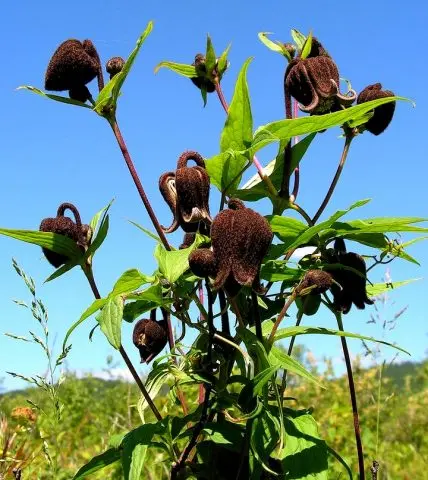
New Love
A compact and exquisitely fragrant variety of Clematis heracleifolia (Clematis heracleifolia) New Love is a low highly ornamental plant, 60-70 cm. It is distinguished by large wavy leaves with carved edges. On a peduncle protruding above the foliage, there are several graceful 4-petal tubular flowers of blue-violet color, resembling a hyacinth. Corolla diameter – 2-4 cm, length 3 cm. It blooms in the second half of summer, the seeds do not have time to ripen before frost. The variety is used for borders, discounts.
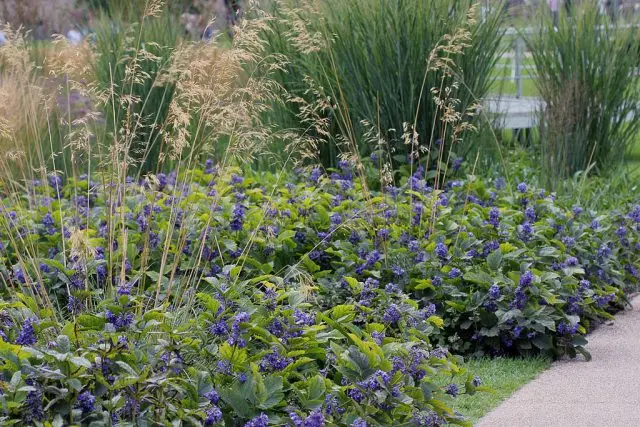
Planting and caring for bush clematis
Herbaceous shrub plants are unpretentious, winter-hardy. Low clematis are planted in spring in regions with a harsh climate, in the south – in autumn.
Selection and preparation of the landing site
Most bush clematis develop well and bloom in sunny and semi-shady areas. Six months before planting, the soil is dug up, mixing per 1 sq. m garden soil with a bucket of compost or humus, 400 g of dolomite flour, 150 g of superphosphate.
Seedling preparation
When buying a bush, they make sure that the buds are visible on the shoots in the spring. The root system of clematis is voluminous, not less than 30-40 cm. Filamentous roots must be elastic, without damage. If the species has a taproot, many small processes extend from the central trunk. Before planting, the roots are soaked in a growth stimulator, following the instructions.
Rules of landing
When planting several bushes, pits 40x40x50 cm in size are dug every 1,5 m. 5-9 cm of drainage material is laid on the bottom. To a substrate of 2 parts of garden soil add:
- 1 part sand, if the soil is heavy;
- 2 part humus or compost;
- 0,8-1 l of wood ash;
- 80-120 g of complex fertilizer, where all three macronutrients are present – nitrogen, potassium, superphosphate.
An approximate algorithm for planting clematis bush in the spring:
- a seedling is placed on a substrate formed by a mound, straightening all the roots;
- a support is driven in nearby, 0,8-2 m high, guided by the declared size of the bush clematis;
- only the roots are sprinkled with soil, leaving the hole not filled to the brim;
- make sure that the growth point is above the level of the garden soil;
- water and fill the hole with peat or mulch.
As shoots appear, the hole is gradually covered with soil. Such a technique when planting clematis will allow the shrub to develop shoots more abundantly. When planting a flower in the fall, the pit is filled with soil at ground level, but then in the spring a layer of up to 10 cm is carefully removed, mulching the recess. By autumn, the hole is gradually covered with soil, as the shoots grow.
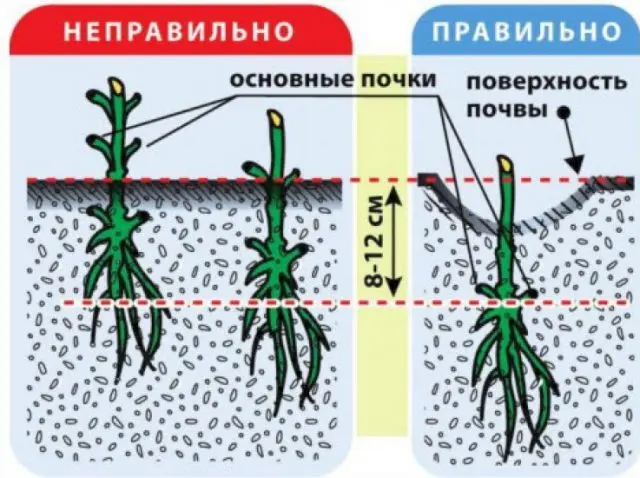
Watering and top dressing
After planting, bush clematis is watered every other day for 2-3 liters, focusing on the amount of natural precipitation. Adult plants are watered once a week – 7-12 liters, depending on size. Watering is especially important in the phase of bud formation and flowering.
The number of flowers and the duration of flowering depends on the amount of nutrients in the soil, which are regularly replenished – after 16-20 days:
- in the spring, 20 g of ammonium nitrate or 5 g of urea are dissolved in 10 liters of water and the plants are poured in half a bucket;
- the next top dressing consists of 100 g of mullein infusion or 70 g of bird droppings per 1-1,5 liters of water;
- during flowering, bush clematis is supported with a solution of potassium sulfate or complex mineral preparations for flowering plants, alternating with organic matter.
Mulching and loosening
After watering, the soil around the bush is loosened, weed sprouts are removed. If necessary, the hole is covered with earth. Then the entire surface around the stems is mulched:
- peat;
- chopped straw;
- rotted sawdust;
- dry grass without seed pods.
Trimming
The formation of a clematis bush is engaged from the beginning of growth:
- in the first year, pinch the tops of the shoots to form new buds;
- also in the first season, half of the buds are plucked, giving the roots the opportunity to develop;
- Clematis with long stems are pruned in summer to guide their growth.
Preparation for winter
In September-October, in the regions, water charging is carried out – up to 20 liters per bush. A week later, the stems are cut at a height of 10-15 cm from the ground. Some bush clematis recommend cutting off completely. Top cover with leaves or peat.
Reproduction
Most types of bush clematis are bred:
- layering;
- grafting;
- division of the bush;
- seeds.
For layering, the extreme shoots are laid in a previously prepared groove, bringing out 10-16 cm of the top above the ground. From the knots sprinkled with soil, sprouts appear after 20-30 days. All this time, the soil above the stem is watered, a solution of the mineral complex is added once. The sprouts are transplanted the next year.
Cuttings are taken from the shoots of a 3-year-old bush before flowering. Having treated with a growth stimulator, the segments are rooted in a mixture of sand and peat. A mini-greenhouse is installed on top. Sprouts are planted in a year, leaving to winter well covered on the street.
The bush is divided at the age of 5-6 years, transplanted into ready-made holes.
Some types of clematis are propagated by seeds that germinate up to 2 months. Seeds are first soaked in water for 6-8 days, changing the solution 3-4 times a day. Shoots of bush clematis appear in 40-58 days. A month later, they are planted in pots, and then in May they are transferred to the garden – to school. A permanent place is determined in the next season.
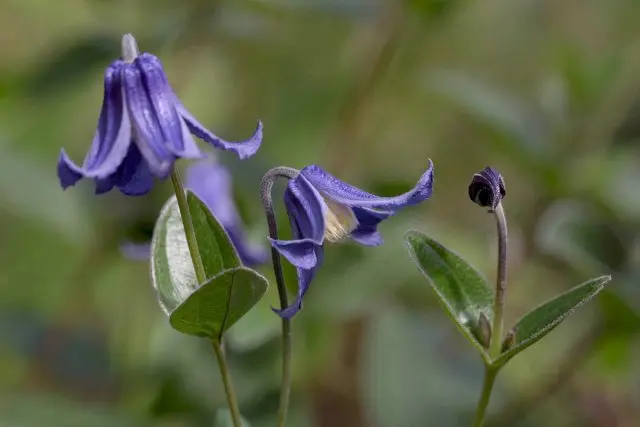
Diseases and pests
In damp, cool or warm weather, plants can become infected with gray mold, powdery mildew, and rust. Diseases are manifested by brown, whitish or orange spots on the leaves. A plant with signs of gray rot is removed, and others that grow nearby are treated with fungicides. Other fungal diseases are treated by spraying with copper-containing preparations:
- from powdery mildew, copper sulfate, “Topaz”, “Azotsen”, “Fundazol” are used;
- for rust use “Polyhom”, “Oxyhom”, Bordeaux mixture.
Clematis is damaged by slugs that eat young shoots, and aphids that suck the juice from the leaves:
- slugs are harvested by hand or special traps and preparations are used;
- aphid colonies are sprayed with a soda-soap solution.
Destroy the nests of ants that carry aphids in the garden, or relocate the ant colony to another place.
Conclusion
Bush clematis is an interesting element of garden compositions. Low-growing bushes are used as a decoration for roses, flowering vines, as a living curtain for the lower part of buildings and fences. Different species can serve as colorful ground covers.









